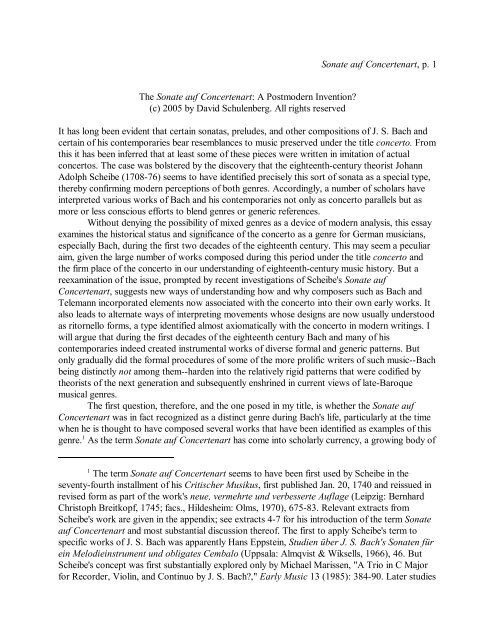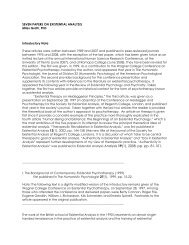The Sonate auf Concertenart: A Postmodern Invention? David ...
The Sonate auf Concertenart: A Postmodern Invention? David ...
The Sonate auf Concertenart: A Postmodern Invention? David ...
You also want an ePaper? Increase the reach of your titles
YUMPU automatically turns print PDFs into web optimized ePapers that Google loves.
<strong>The</strong> <strong>Sonate</strong> <strong>auf</strong> <strong>Concertenart</strong>: A <strong>Postmodern</strong> <strong>Invention</strong>?<br />
(c) 2005 by <strong>David</strong> Schulenberg. All rights reserved<br />
<strong>Sonate</strong> <strong>auf</strong> <strong>Concertenart</strong>, p. 1<br />
It has long been evident that certain sonatas, preludes, and other compositions of J. S. Bach and<br />
certain of his contemporaries bear resemblances to music preserved under the title concerto. From<br />
this it has been inferred that at least some of these pieces were written in imitation of actual<br />
concertos. <strong>The</strong> case was bolstered by the discovery that the eighteenth-century theorist Johann<br />
Adolph Scheibe (1708-76) seems to have identified precisely this sort of sonata as a special type,<br />
thereby confirming modern perceptions of both genres. Accordingly, a number of scholars have<br />
interpreted various works of Bach and his contemporaries not only as concerto parallels but as<br />
more or less conscious efforts to blend genres or generic references.<br />
Without denying the possibility of mixed genres as a device of modern analysis, this essay<br />
examines the historical status and significance of the concerto as a genre for German musicians,<br />
especially Bach, during the first two decades of the eighteenth century. This may seem a peculiar<br />
aim, given the large number of works composed during this period under the title concerto and<br />
the firm place of the concerto in our understanding of eighteenth-century music history. But a<br />
reexamination of the issue, prompted by recent investigations of Scheibe's <strong>Sonate</strong> <strong>auf</strong><br />
<strong>Concertenart</strong>, suggests new ways of understanding how and why composers such as Bach and<br />
Telemann incorporated elements now associated with the concerto into their own early works. It<br />
also leads to alternate ways of interpreting movements whose designs are now usually understood<br />
as ritornello forms, a type identified almost axiomatically with the concerto in modern writings. I<br />
will argue that during the first decades of the eighteenth century Bach and many of his<br />
contemporaries indeed created instrumental works of diverse formal and generic patterns. But<br />
only gradually did the formal procedures of some of the more prolific writers of such music--Bach<br />
being distinctly not among them--harden into the relatively rigid patterns that were codified by<br />
theorists of the next generation and subsequently enshrined in current views of late-Baroque<br />
musical genres.<br />
<strong>The</strong> first question, therefore, and the one posed in my title, is whether the <strong>Sonate</strong> <strong>auf</strong><br />
<strong>Concertenart</strong> was in fact recognized as a distinct genre during Bach's life, particularly at the time<br />
when he is thought to have composed several works that have been identified as examples of this<br />
1<br />
genre. As the term <strong>Sonate</strong> <strong>auf</strong> <strong>Concertenart</strong> has come into scholarly currency, a growing body of<br />
1<br />
<strong>The</strong> term <strong>Sonate</strong> <strong>auf</strong> <strong>Concertenart</strong> seems to have been first used by Scheibe in the<br />
seventy-fourth installment of his Critischer Musikus, first published Jan. 20, 1740 and reissued in<br />
revised form as part of the work's neue, vermehrte und verbesserte Auflage (Leipzig: Bernhard<br />
Christoph Breitkopf, 1745; facs., Hildesheim: Olms, 1970), 675-83. Relevant extracts from<br />
Scheibe's work are given in the appendix; see extracts 4-7 for his introduction of the term <strong>Sonate</strong><br />
<strong>auf</strong> <strong>Concertenart</strong> and most substantial discussion thereof. <strong>The</strong> first to apply Scheibe's term to<br />
specific works of J. S. Bach was apparently Hans Eppstein, Studien über J. S. Bach's <strong>Sonate</strong>n für<br />
ein Melodieinstrument und obligates Cembalo (Uppsala: Almqvist & Wiksells, 1966), 46. But<br />
Scheibe's concept was first substantially explored only by Michael Marissen, "A Trio in C Major<br />
for Recorder, Violin, and Continuo by J. S. Bach?," Early Music 13 (1985): 384-90. Later studies















